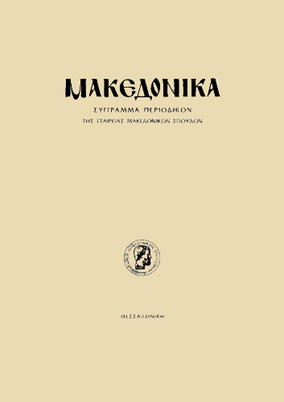Ανέκδοτο αρχειακό υλικό για τη Μονή Τιμίου Προδρόμου (Σκήτη) Βέροιας
Part of : Μακεδονικά ; Vol.31, 1998, pages 239-258
Issue:
Pages:
239-258
Parallel Title:
, Unpublished Archival Material Relating to the Monastery (Skete) of St John the Baptist at Veria.
Section Title:
Articles
Abstract:
This study looks at the privileges, the financial affairs, and abbots and monks of the monastery in the Ottoman period as reflected in 75 unpublished patriarchal letters, dated between 1692 and 1909. To begin with, we are informed that the coenobitic Monastery of St John the Baptist was always stauropegic (directly subject to the Oecumenical Thro ne), but paid an annual subscription not only to the Patriarchate, but also to the Metropolitanate of Veria. However, owing to the circumstances of the time and also to the mis conduct of some of the monks, the monastery was frequently in danger of losing all its inmates and running heavily into debt, which meant that it had difficulty in meeting its commitments. At these times, the Christian communi ty of Veria came to the monastery’s aid, unlike some of the metropolitans, who violated the patriarchal foundation’s rights at various times. Owing to the monastery’s continuing problems, and in order to regulate its constitution, its manner of administration, and, above all, its financial affairs, various patriarchal exarchs were sent to the monastery from time time to set it on its feet again. An important part in restoring and improving the monastery’s affairs was also played by the election of capable abbots, who were frequently natives of Veria and co-operated amicably with the various metropolitans. The fact that insubordinate clerics were physically confined to the monastery and kept under surveillance by the Abbot shows how well organised the monastic life was there. Apart from sending exarchs, the Patriarchate also monitored the stauro pegic monasteries by means of the so-called Monastic Commission, which was responsible for recording the monastery’s estate in the land registry. Third parties frequently laid claim to monastic property and the cases had to be settled in court. The monks also addressed their financial problems by selling animals, crops, and other movable objects. At the same time, the Patriarchate advised the abbots to take administrative measures, such as selecting capable monks to sit on the Abbatial Council. But the greatest contribution to the monastery’s proper administration and, above all, to its economic recovery was made by the Management Committee, which consisted of the Metropolitan (as chair man), the Abbot, and two laymen.The Committee’s work was repeatedly acknowledged by the Oecumenical Throne, and one of its achievements was to increase the financial contributions the monastery was able to make to the schools of Veria and the ecclesiastical funds of the Patriarchate. Another was to establish a seminary in the monastery, a historic event for the circumstances of the time and the region of Macedonia.
Notes:
856:https://ejournals.epublishing.ekt.gr/index.php/makedonika/article/view/5684, DOI: https://doi.org/10.12681/makedonika.123
Electronic Resources:




